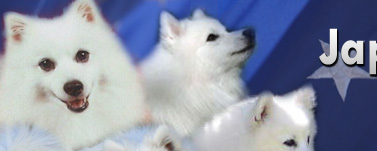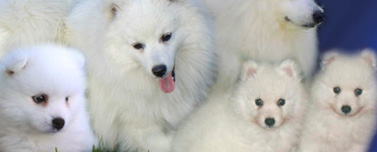SECRETARIAT
GENERAL: 13, Place Albert I — B 6530 THUIN (Belg.)
FCI-Standard
N0 262 /16. 06. 1999 / GB
JAPANESE SPITZ (Nihon Supittsu)
ORIGIN: Japan.
DATE OF PUBLICATION OF THE
ORIGINAL VALID STANDARD: 1987.
UTILIZATION: Companion dog.
CLASSiFiCATiON
F.C.I.: Group
5 Spitz and
primitive type. Section 5 Asian Spitz and related breeds. Without working
trial.
BRIEF HISTORICAL
SUMMARY
: The origin of
the Japanese Spitz is said to be the large-sized white German Spitz brought to
Japan around 1920 via the continent of Siberia and northeast part of China.
Around the year 1921 the breed was first exhibited at a dog show in
Tokyo.
Subsequently, in 1925, two pairs
of white Spitz were imported from Canada, and until around 1936, imports came
from Canada, the U.S., Australia and China. Eventually their offspring were
crossbred to produce a better breed. After the 2nd World War, the unified breed
standard was established by the Japan Kennel Club in 1948 to be valid to the
present.
GENERAL
APPEARANCE : Covered with profuse pure white
coat, with pointed muzzle, triangular pricked ears, and feathering tail over
back. The constitution tough and the whole well balanced, its harmonious beauty
causing spirit and dignity peculiar to this breed, and expressing
elegance.
IMPORTANT
PROPORTION
: The ratio of
height at withers to length of body is 10:11.
BEHAVIOR
I
TEMPERAMENT : Intelligent, cheerful, keen in
sense. Noisy not permitted.
HEAD: Size in balance to body,
moderately broad and rounded.
CRANIAL REGION:
Skull : Forehead moderately developed.
Rear part of skull broadest.
Stop : Defined.
FACIAL REGION:
Nose : Small, round and
black.
Muzzle: Pointed, the tip slightly round,
and well balanced. Lips tight and preferably black.
Jaws/Teeth : Teeth white and strong with
scissor bite.
Eyes : Moderately large,
almond-shaped, set slightly oblique, dark in color. Black eyerims.
Ears : Set on high, small, triangular,
pricked, facing forward, and not too far apart.
NECK Moderately long, muscles well
developed.
BODY
Withers : High.
Back: Straight and short.
Loins : Broad.
Chest: Wide and deep, ribs well
sprung.
Belly: Well tucked up.
TAIL : Set on high, moderately long,
carried over back.
LIMBS
FOREQUARTERS : Shoulders well sloping,
forearms straight, elbows tight.
HINDQUARTERS : Muscular, stifle and hock
moderately bent.
FEET: Cat-feet. Pads thick, and
desirably black as well as the nails.
GAIT/MOVEMENT : Quick and active.
COAT
HAIR : Outer coat straight and
stand-off. Undercoat short, soft and dense. The foreface, ears, front of
forearms and part below hocks are short haired, and the rest covered with
abundant long coat, especially from neck to shoulders and forechest covered with
beautiful frill, and the tail also has long profuse feathering.
COLOUR: Pure white.
SIZE
Height at withers : Dogs 30-38 cm. Bitches slightly
smaller than dogs.
FAULTS : Any departure from the foregoing
points should be considered a fault and the
seriousness with which the fault should be regarded should be in exact
proportion to its degree.
· Overshot or undershot
mouth.
· Strongly curled
tail.
· Shyness; noisiness.
ELIMINATING FAULTS:
· Drop ears.
· Tail not carried on
back.
N.B.: Male animals should have two
apparently normal testicles fully descended into the
scrotum.







